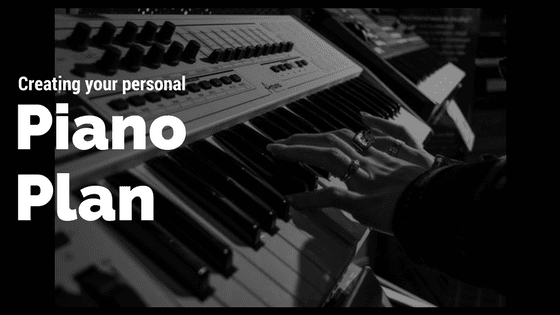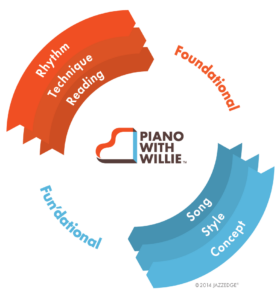Creating Your Personal Piano Plan

It is a challenge to learn an instrument. You begin with a burning desire to express yourself through music but soon you realize just how much of a commitment it is.
If you're like most students, you will progress quickly during the first few months but then you hit 'the wall.' Everyone hits the wall at some point.
The wall is the point at which you say things to yourself like "I can't do this!", "Why am I not getting better?" or "I have no clue what I should practice!?!"
These are frustrating thoughts to be sure! However, there is a solution that you can accomplish on your own, without outside help.
The solution is to create a Personal Piano Plan.
What is my Personal Piano Plan?
Your Personal Piano Plan is the road map that you follow to aligned your piano dreams and practice.
My piano dreams you ask? Yes dreams. However, these are not dreams of you running through a bed of roses throwing quarter notes into the air! Think of them more like your goals.
Your piano dreams are how you answer this statement: "Someday, I want to be able to ___ at the piano." You might fill the blank with "play my favorite song", "improvise", "compose" or just "have fun." The point is, these are your goals and dreams...no one elses.
Your piano dreams are WHY you want to play the piano in the first place.
Now, let's bring practice into the equation.
When we sit to practice, we may or may not know why we are practicing this or that. We might not even know how our practicing is benefiting us in the long run.
This is BAD.
Why you need to know what you don't know.
If you don't know the reason behind your practice routine, it is sure to fail. I hate to be so "doom and gloom" but it is true.
Facts are, we have limited time as adults (unless we are one of those lucky few who can devote hours a day to the piano) to sit and practice.
Now, let me take a quick moment to remind you that practicing is not playing. When you practice, basically, you should sound 'bad.' To clarify, you should need to start and stop again to focus on sections or 'chunks' of music. If you are playing top-to-bottom without mistakes, chances are...you're just playing. That's O.K., but it's not practicing.
Since we have such limited time to practice, we want to be sure we know what we are doing before we get started.
For example, we wouldn't leave on a road trip without knowing where we were going. Right? If so, I'm bringing my GPS with us!
We need a plan and we need to know the plan. Think of this as GPS for the piano.
Are you holding up the line?
We can compare learning an instrument to being on a freight train. My 5-year-old son Connor loves trains, so trains it is!
As you move down the track a different piece of cargo is added to your load. You travel a ways and new cargo is consistently added to your train.
We follow a similar process as humans. We learn something, then add to that knowledge incrementally. Compare this to adding more cargo to our freight train.
We can't learn everything at once. Wouldn't that be nice? We need to make stops along the way. Remember back to school days when you were 'cramming' the night before a test? It just can't be done. And, if you're lucky enough to remember the information for the test...it soon slips away.
So we move along this track, or 'path,' and learn/add one thing after another to what we know. We learn something, we practice it and we learn the next thing, whatever that is.
Imagine the same train, but this time it is constantly stopping and going. It moves forward a bit, but quickly goes back because it forgot something at the station. This would be inefficient to say the least!
Unfortunately, this is how many students structure their practice routine. "A little of this...a little of that" without any real goals, structure or assessment. They practice a concept for a bit, then move to something else, then back again all without creating forward momentum in their practice routine.
Practice plan fundamentals
We want forward momentum in our practice routine. So how do we get it?
The first step is to focus on your piano fundamentals. Your fundamentals are: Rhythm, Reading and Technique.
Working your piano fundamentals doesn't have to be boring. After all, the word 'fun' can be found in fundamentals! Sorry...bad joke. It's true though. I think you'll agree that practicing fundamentals gives you some concrete tools to see growth. There is always the time and the need to work on piano fundamentals.
Let's go through each of the fundamentals...
Rhythm: In my opinion, rhythm is the single most important musical element. Without good rhythm, everything else falls apart. However, wrong notes can be easily covered up with a strong rhythm. Even the artist Henri Matisse mentions the importance of rhythm: "Jazz is rhythm and meaning."
Reading: Many 'by ear' players ask "Why do I need to read sheet music?" My answer is "You don't. Well, at least not the way we usually think of reading sheet music." You don't need to sit down and read a Chopin etude. However, you do, at a minimum, need to know how to read a melody and understand how to form chords. This will make it easier to play with others, learn new music and write your own compositions for other musicians to learn!
Technique: It's frustrating to not be able to play what you hear, right? Working on technique brings us closer to play what we hear in our ears. Without good technique, we are always struggling to 'get out' on the piano what we hear 'inside.'
It's your turn to be the conductor.
Now that you understand that you need to work on your fundamentals, you can have some fun with your plan. You can drive the train.
You've followed the foundation track and now you've come to a switch. You get to decide the direction that you follow next. You can follow one of three tracks: 1) Song, 2) Style or 3) Concept. Why only three? Well, I find it easier if you think in 3's rather than overwhelming yourself with choices.
Let's follow the tracks and see where they lead us...
- Song: This pretty straightforward. After working on your fundamentals, you dive into learning songs. These might be from different genres or styles. This is how you develop your repertoire. If you want to play with others or play solo/cocktail piano, you may decide to follow this track.
- Style: You would choose this track if you want to focus on a specific genre of music like Blues, Jazz, Funk, Gospel etc. By focusing style-specific, you can bring the style into pieces of music that might not originally be in that style. For instance, if you decide to focus on Latin-style, specifically (Brazilian) Bossa Nova, you can then try to apply that style to maybe a Rock song or Jazz standard. For example, playing Misty in a Bossa Nova feel.
- Concept: This is the most powerful and flexible track that you can follow. Within the concept track we include: improvisation, chords, re-harmonization, licks, intros, endings and many more. Concepts are not usually something you would play standalone. They are usually applied to songs or grooves.
How do I know if I'm on the right track?
The only way for you to know if you are on the right track is for you to assess your playing and progress. Even if you are working with a private teacher, it is important for you to self-assess your progress. Why?
As your teacher, I will have an idea of a direction that I want you to go. It is up to you however to decide if you are "off track" with your piano dreams.
Thought we were done with the dreams huh? Nope! Your piano dreams or goals are what you use to consistently track your progress. Remember the GPS for piano. Well re-assessing your progress from time-to-time keeps you on the map.
To begin, ask questions like "Am I making the progress I want to make?" or "Am I playing the music I want to play?"
The answers (which only you know) to these questions will help you decide the next track to take. You always stay on the foundation track, but you can decide the Song, Style or Concept track to take next.
4 Steps to create your own Personal Piano Plan.
- Identify your piano goals. Read my article on How To Get Better At The Piano.
- Create a list of foundation practice routines that you can play on a regular basis. These might include:
- All 12 Major scales
- Hanon exercises
- Chromatic exercises
- Quartals and pentatonics
- Left-hand exercises, etc...
- Choose a track to follow: Song, Style or Concept. When you choose, make a commitment to stay on that track for at least X days before moving on. If it is easy, you might only stay on that track for 2 weeks before moving on to a different track.
- While always working foundational principles, you can move between tracks to create your own Personal Piano Plan!
